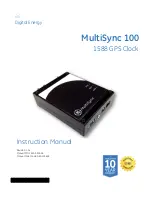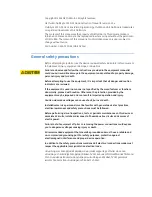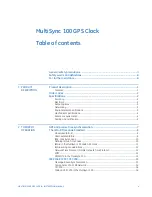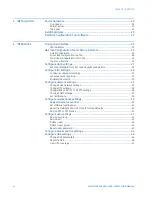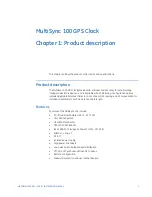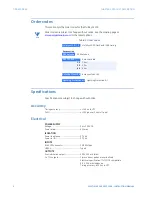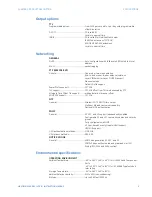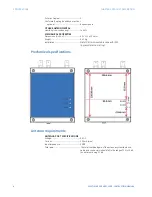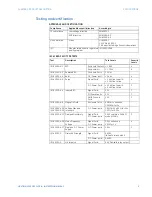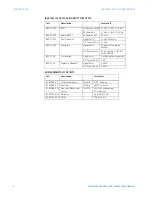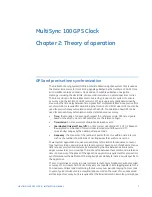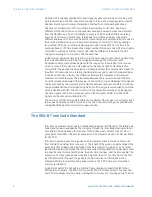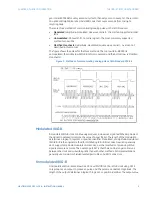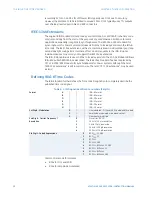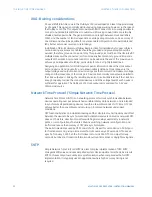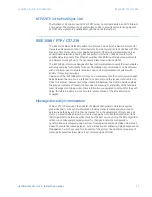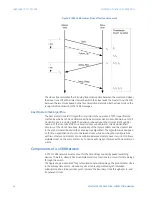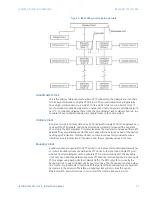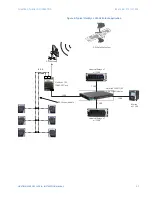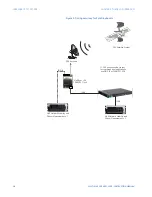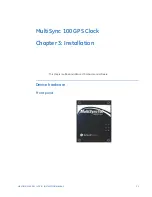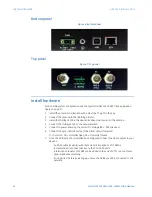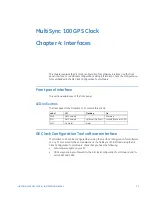
8
MULTISYNC 100 GPS CLOCK – INSTRUCTION MANUAL
THE IRIG-B TIME CODE STANDARD
CHAPTER 2: THEORY OF OPERATION
stability. GPS is capable of global time and frequency dissemination 24 hours a day, with
timing accuracies in the 100-nanosecond range. This level of accuracy explains why GPS
has become the typical time synchronization method for commercial applications.
GPS time is not identical to UTC (or civil) time, but is related to UTC time. One major
difference is that GPS time is a continuous time usually measured in weeks and seconds
from the GPS time zero point of midnight, January 6, 1980. The other difference is leap
seconds. UTC time is an atomic time, is the basis for civil time, and aims to keep the
difference between UTC time and the earth's rotational speed to less than 0.90 seconds. As
the earth's rotation slows down, it becomes necessary to correct UTC time by adding a
leap second. GPS time is not adjusted by leap seconds, and as of 2014, GPS time is 16
seconds ahead of UTC time. Beyond the integer number of leap seconds, GPS time is tightly
controlled to within one microsecond of UTC, with the difference reported in the GPS
navigation message to a precision of 90 nanoseconds.
A GPS receiver gains GPS time by locking on to the spread spectrum carrier and decoding
the 50-Hz datastream containing the navigation message. The total signal path
transmission delay computation begins with the range from the satellite to the receiver.
One can convert the range to a time delay using the speed of light. This delay is then
corrected for the ionospheric delay (using a model provided in the navigation message), for
the effect of transmission in a rotating inertial reference system, and for hardware delays
in cables and receiver circuitry. The difference between the computed and measured
millisecond time marks gives the relationship between the receiver clock and GPS time.
Once the relationship between the receiver clock and GPS time is established, time signals
can be produced by the receiver. Synchronization between receivers at different locations
can be established and maintained using GPS time. If time signals are required to maintain
synchronization with UTC, the UTC correction in the navigation message can be applied,
and time signals, such as one-pulse-per-second (1PPS) signals of IRIG-B or IEEE 1588
signals, can be set and maintained to UTC.
The accuracy of GPS time signals is related to the ability of the receiver to accurately track
the received navigation code. Accuracies in the 100-nanosecond range are possible with
undegraded GPS signals and correct receiver position.
The IRIG-B Time Code Standard
IRIG-B is one of several time code formats defined under the IRIG Standard. The IRIG-B time
code standard was developed by the U.S. Army through the Inter-Range Instrumentation
Group (IRIG). IRIG-B defines a frame time of 1000 milliseconds, a frame rate of 1 Hz or 1
pulse per second (PPS), a bit time (or pulse time) of 10 milliseconds, and 100 bits per frame
(or 100 PPS).
IRIG-B is an analog signal: analog pulses (or bits) represent time in fractions of seconds
from midnight, and days from January 1st. The length of the pulse, as a percentage of the
pulse time of 10 milliseconds, determines if the bit is a logical 0, a logical 1, or a position
identifier. As the bit rate implies, the IRIG-B time code format publishes 100 bits per second
in a specific order to represent the time, the date, time changes, and the time quality. The
presence of 2 consecutive position identifiers signifies the start of a time frame. The first
identifier alerts that the next rising edge is the frame marker. As IRIG-B has a 1000
millisecond frame interval, this rising edge marker is the "1 PPS" time synchronization
commonly referred to.
A significant part of the 100 bits in an IRIG-B frame are Binary Coded Data (BCD) that
defines the actual time. The BCD time-of-year (BCDTOY) indicates seconds, minutes, and
hours from midnight, recycling daily, and days from January 1st, recycling yearly. The BCD

